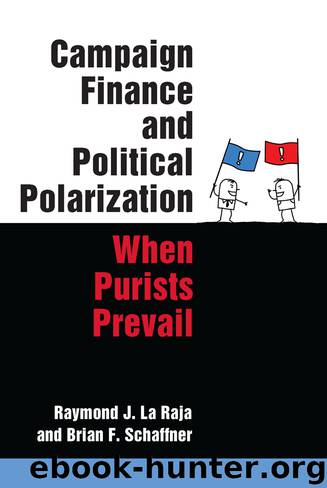Campaign Finance and Political Polarization: When Purists Prevail by La Raja Raymond J. & Schaffner Brian F

Author:La Raja, Raymond J. & Schaffner, Brian F.
Language: eng
Format: epub
Publisher: University of Michigan Press
Published: 2018-05-15T00:00:00+00:00
Hypothesis 2: Party-Centered Campaign Finance Reduces Polarization in Legislatures
We next explore our second hypothesis: that a party-centered campaign finance system will make legislatures less polarized, which could improve the governing process. In Congress and many states the politics of compromise, which seems necessary in a separated system of powers, appears to be hard to practice because party members are so far apart on their preferences. But if the distance between parties could be lessened, it seems conceivable that a legislature might become more fertile ground for transactional politics and the kind of across-the-aisle bargaining that leads to bipartisan legislation.
Page 101 →
First, we consider the prospects for finding common ground. We think this is more likely to happen when some members of both parties share ideological preferences. In times of divided government, moderates in the legislature often form the core of bargaining agreements between branches of government (Trubowitz and Mellow 2005). Moderates reflect the “pivot,” and the greater the number of legislators who occupy the pivot, the stronger their leverage to forge bipartisan agreements. We measure bipartisanship as the percentage of legislators whose ideology overlaps with at least one opposing party member’s ideology. In figure 4.4, we compare the ideological overlap between states with and without campaign finance restrictions. (Our measure simply reflects the area in figure 4.3 where the Democratic and Republican distributions overlap.) It is clear that ideological overlap is greater in states where the parties have no restrictions on making contributions and raising money from individuals. In these states, about 10.5 percent of legislators overlap in their preferences with at least one member of the Page 102 → opposing party, whereas in states with limits only about 8 percent do. While the difference does not appear to be large, in percentage terms the move from 8 percent to 10.5 percent reflects more than a 20 percent increase in bipartisanship.8
Finally, we seek to directly test our expectations that party-centered campaign finance laws would attenuate, and perhaps even reverse, legislative polarization in the states. While our earlier analyses used individual legislators as our units of analysis, in this case we look at the legislatures themselves. Our dependent variable is simply the distance between the median Democrat and the median Republican in each legislative chamber. When that distance is greater, it means that the parties are more polarized in the legislature; when the distance is smaller, it means that there is less polarization. The mean level of polarization during the years of our study was 1.33 (standard deviation of .47). The levels of polarization ranged from 0.42 in the Rhode Island Senate in 2003 and 2004 to 3.21 in the California House in 2007 and 2008.
Our key independent variable is, once again, an indicator of whether a state limited the extent to which parties could raise and spend money on legislative campaigns. When a state was limited in either the amount it could raise from individuals or the amount it could give to candidates, the variable was coded as a 1. When there were no such limits, the variable was set to 0.
Download
This site does not store any files on its server. We only index and link to content provided by other sites. Please contact the content providers to delete copyright contents if any and email us, we'll remove relevant links or contents immediately.
The Secret History by Donna Tartt(18952)
The Social Justice Warrior Handbook by Lisa De Pasquale(12171)
Thirteen Reasons Why by Jay Asher(8849)
This Is How You Lose Her by Junot Diaz(6839)
Weapons of Math Destruction by Cathy O'Neil(6221)
Zero to One by Peter Thiel(5736)
Beartown by Fredrik Backman(5683)
The Myth of the Strong Leader by Archie Brown(5463)
The Fire Next Time by James Baldwin(5390)
How Democracies Die by Steven Levitsky & Daniel Ziblatt(5175)
Promise Me, Dad by Joe Biden(5117)
Stone's Rules by Roger Stone(5055)
A Higher Loyalty: Truth, Lies, and Leadership by James Comey(4909)
100 Deadly Skills by Clint Emerson(4883)
Rise and Kill First by Ronen Bergman(4741)
Secrecy World by Jake Bernstein(4703)
The David Icke Guide to the Global Conspiracy (and how to end it) by David Icke(4660)
The Farm by Tom Rob Smith(4469)
The Doomsday Machine by Daniel Ellsberg(4453)
